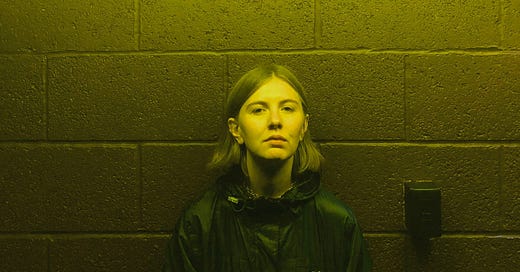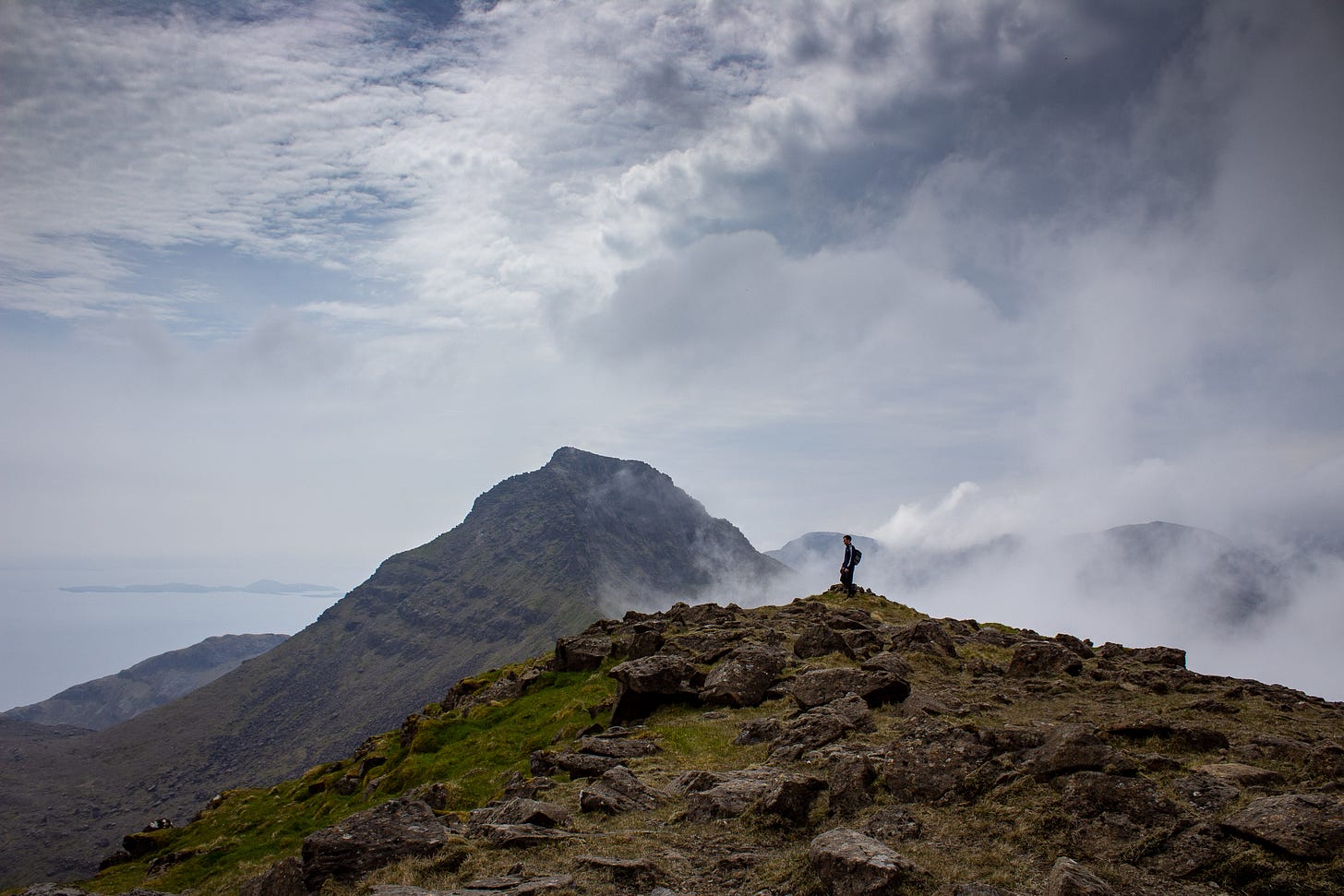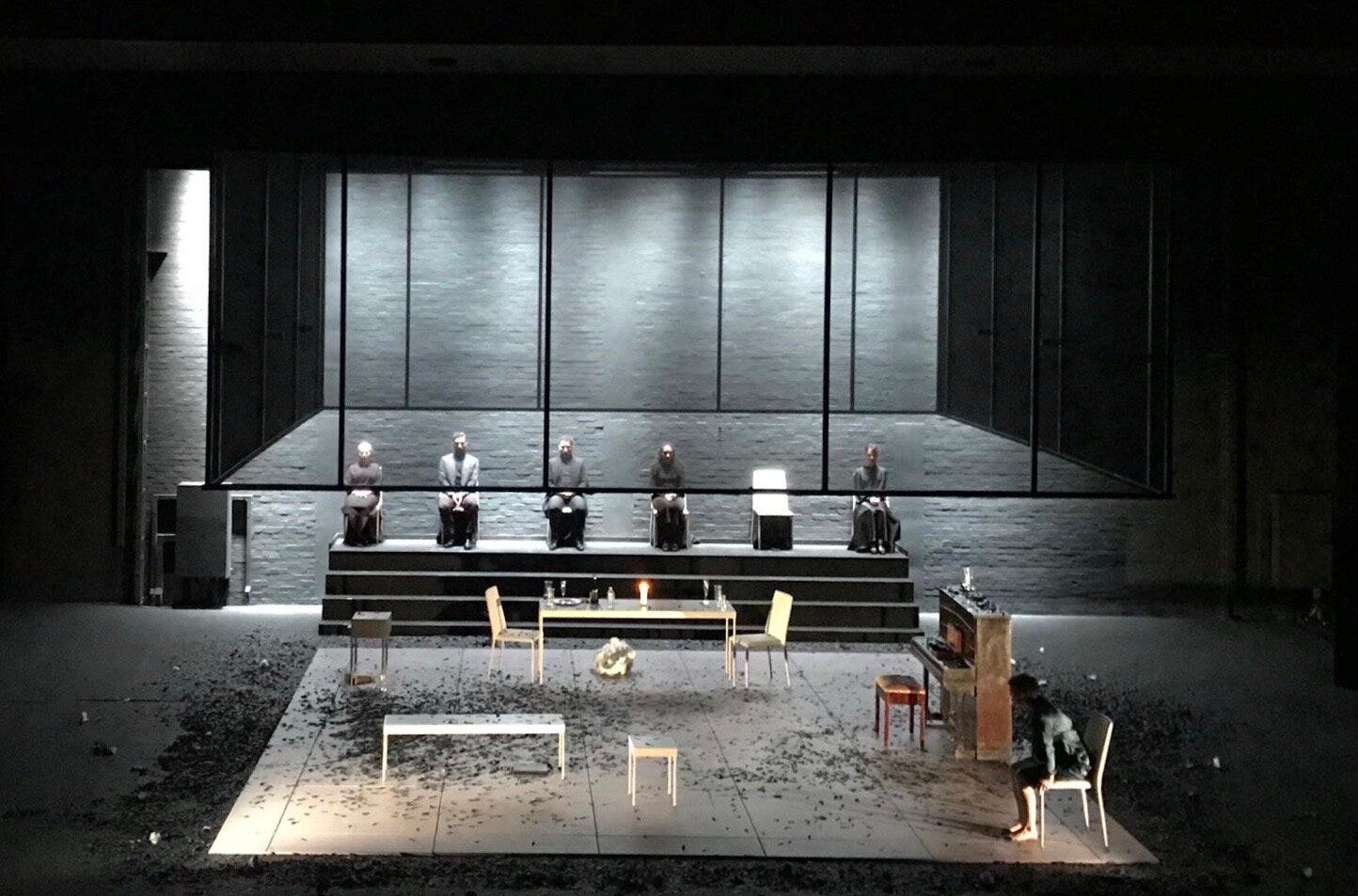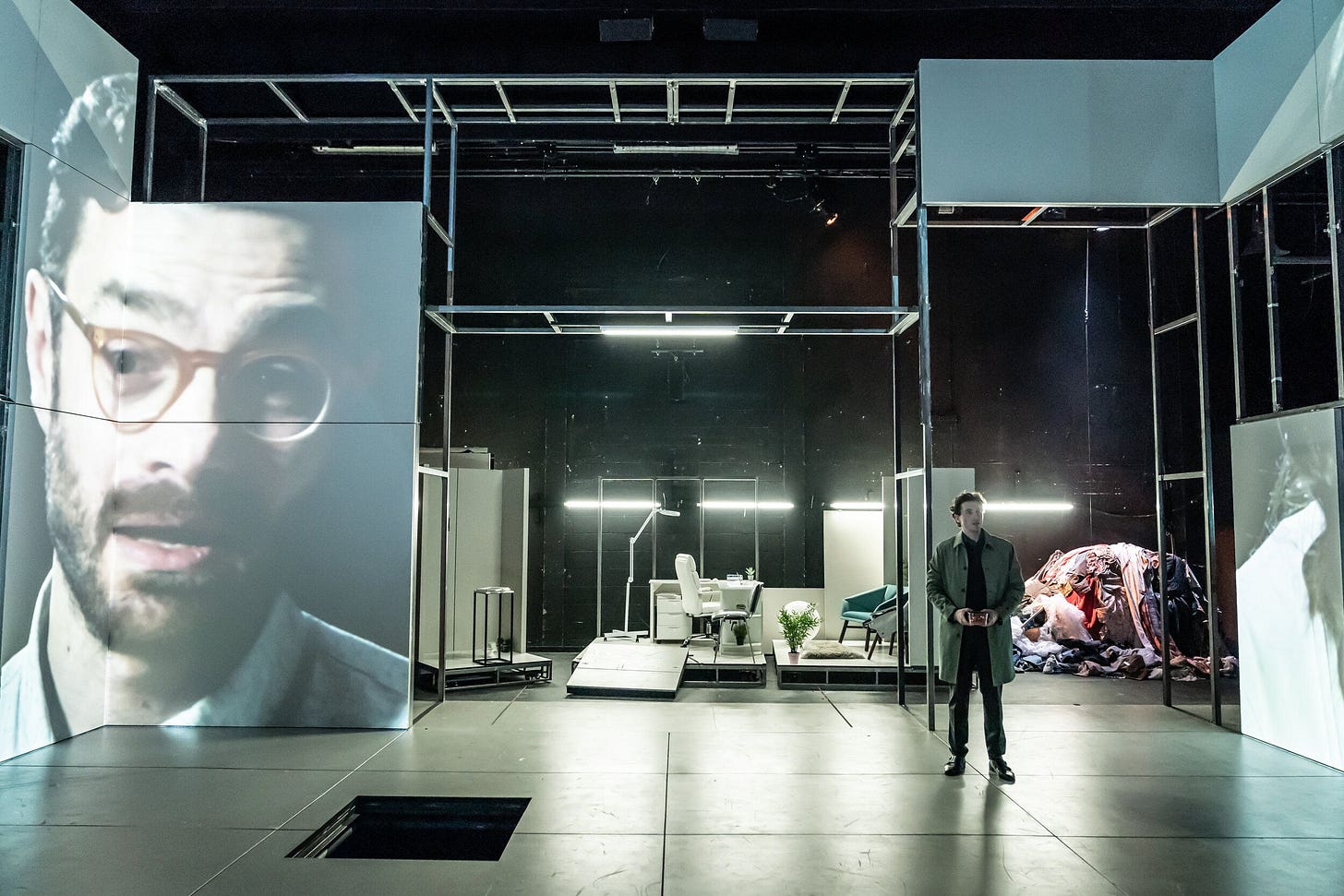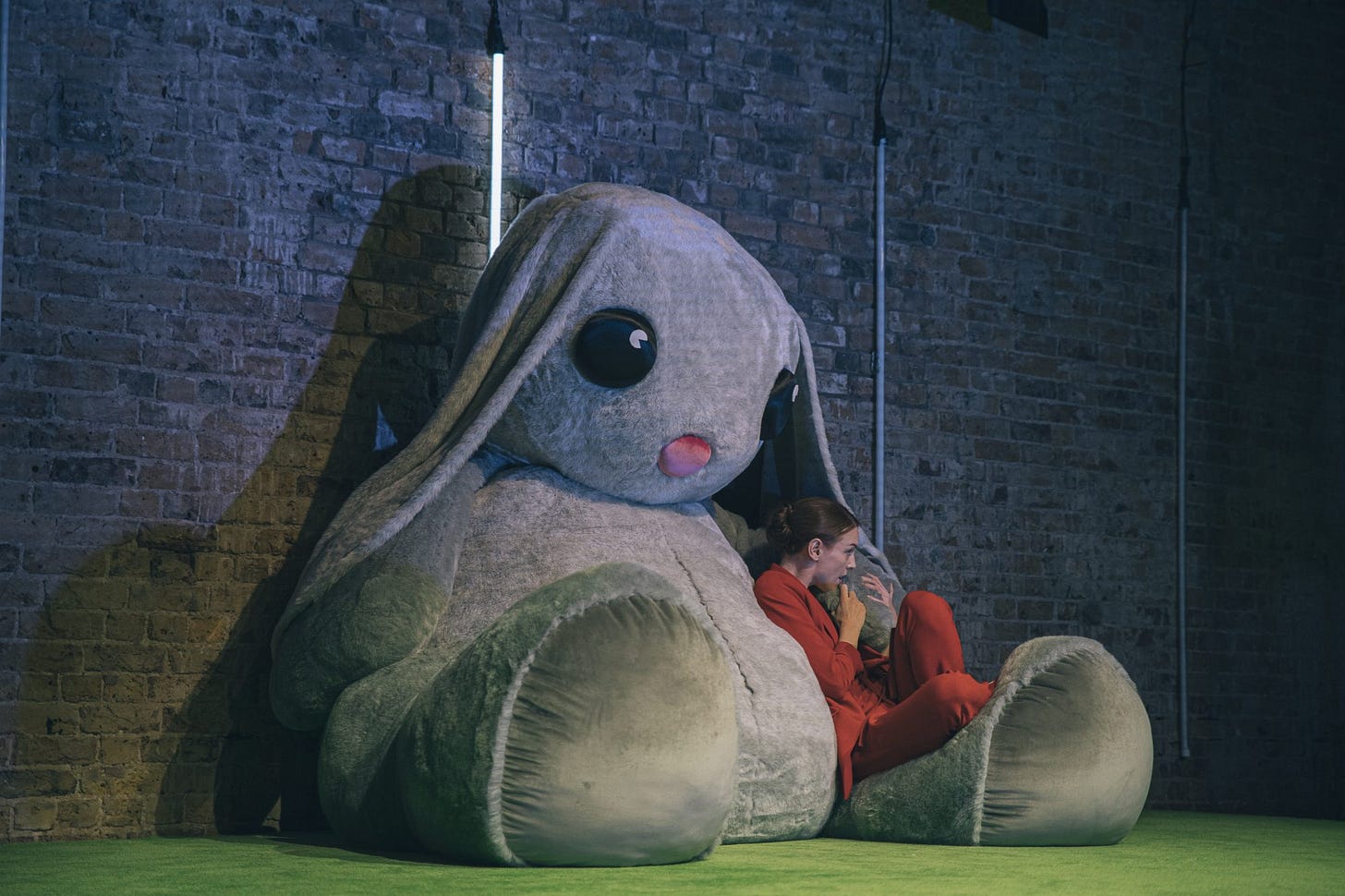Rosanna Vize - designer, maker, bühnenbild
Meet the designer behind that giant, stuffed bunny at the Bush.
Long time, no see…
Hello. How’s it going? It’s been a while. Sorry I didn’t send out an issue a fortnight ago. I was on the remote Isle of Rum in the Hebrides, where there wasn’t much in the way of WiFi. There is, however, some very big hills. Here’s a photo I took from the top of one. That wee island you can see in the background is Muck.
Anyway, enough holiday snaps. Welcome to the twelfth issue of The Crush Bar, my fortnightly (usually) newsletter about theatre and the people that make it. The last issue with David Byrne of the New Diorama generated quite a lot of new subscribers, so for some of you this is the first time I have popped up in your inbox. How exciting. If you haven’t subscribed yet, then please…
Below, you’ll find an interview with “designer” Rosanna Vize - the air quotes are because, as you will read, she’s not sure whether that’s the right label for what she does - about her approach to work, about some of the issues with freelance designing in this country, and about that giant, stuffed bunny she put on stage for Harm at the Bush Theatre.
One last thing for now - if you could share this somehow, that would be great. Forward it to someone who might be interested. Tweet about it. Email GB News about it. Whatever you want. Thanks in advance.
Okay. Here’s the interview. See you at the bottom for some other bits and bobs.
Interview: Rosanna Vize
Rosanna Vize learned some German last year. Her friend and fellow designer Max Johns is bilingual, she explains, and gave her some lessons over Zoom. She did not get far – it was one of those lockdown hobbies that we all entertained for about a fortnight – but she did learn one handy word.
“Ich bin ein bühnenbild,” she says. “It’s something like that, anyway, and it means something like ‘picture-maker’ or ‘image-maker’, and that feels different from ‘set designer’ or ‘costume designer’. It feels more like the sort of thing I do. I’m more like a cinematographer, a framer, a director of image.”
That distinction is important to Vize. She graduated from Bristol Old Vic in 2013, was a finalist in that year’s Linbury Prize for emerging stage designers, and has been working professionally ever since. It is only recently, however, that she feels she has finally “got into her stride”, and realised that the label ‘designer’ – and the traditional role it brings with it in British theatre – does not fit her.
“Think about Peter Brook and the white box. We never even mention the name of the designer who created that idea with him, Sally Jacobs…”
Too often, she says, designers are seen not as artists but as functionaries, able do a job on any show, any day of the week - as, in her words, “the person that decides the size and shape of the director’s idea”.
And, although British designers are a “versatile gang” – they have to be because of working conditions, more on which later – that definition does them an injustice as creatives with their own approach and their own aesthetic. As Vize puts it: “You wouldn’t expect a musician to be able to suddenly write completely different music on demand. You wouldn’t expect Joni Mitchell to start producing psytrance.”
“The idea of being a ‘set and costume designer’ is limiting and doesn’t really encompass what most of us are doing,” she continues. “We are building the conceptual life of an event, framing it, redefining the edges of the ‘world’. We are baking the idea with a director, and thinking about every aspect that will allow that idea to sing.”
What is the answer? Perhaps, Vize says, it is changing the label we use for the role she does, as her brief foray into German suggested. Or perhaps, it is in making sure we credit designers as much as we credit directors. “Think about Peter Brook and the white box,” she points out. “We never even mention the name of the designer who created that idea with him, Sally Jacobs, do we?”
Vize worked on several projects in 2019, the year she “got into her stride”. In March, Sam Yates’ production of Ella Road’s The Phlebotomist, which Vize designed, jumped from Hampstead Theatre’s downstairs studio onto its main stage. In September, the Galway International Arts Festival production of Paul Muldoon’s Incantata – again directed by Yates and designed by Vize – arrived at Dublin’s Gate Theatre. And in October, Vize collaborated with director Chelsea Walker on Hedda Gabler at Cardiff’s Sherman Theatre.
Each of those productions was visually striking in its own way. In Hedda Gabler, a huge metal cage descended remorselessly over a sparse, ash-strewn set. In Incantata, large-scale projections lit up a wide, flat stage, while a massive mound of potatoes lurked in the corner. In The Phlebotomist, a clinical white box was again illuminated by vast video.
What was it about those shows that made Vize feel so fulfilled? Partly it was the projects themselves – all innovative, all experimental. Partly it was the process of putting them together, of being in a room with other creatives, ‘bühnenbild’-ing. But mostly, Vize says, it was the people. Well, the person.
“I think what I like most about designing performance is that relationship with a director,” Vize says. “That relationship is my drug. I love it. I don’t know why exactly. I think I’m probably just a naturally very co-dependent person. I like the camaraderie. I think there’s something really special about that central relationship.”
There are myriad examples of director-designer partnerships in theatre that continue to produce show after powerful show, the relationship moving and maturing over time: Michael Grandage and Christopher Oram, Declan Donnellan and Nick Ormerod, Ivo Van Hove and Jan Versweyveld, to name three.
“I want that relationship,” says Vize. “I’ve seen what Ivo and Jan do together, and I think that comes out of their marriage, and I want that director-designer marriage. Except I don’t want just one. I want, like, five.”
“It is like having the other half of your brain in the room. It is like we are the parents of a production together…”
Vize thinks she already has two. One with Walker, with whom she created Hedda Gabler in Cardiff, Yous Two at Hampstead Theatre, and Low Level Panic at the Orange Tree Theatre; and one with Yates, with whom she worked on The Phlebotomist and Incantata, and with whom she is currently collaborating on Tennessee Williams’ The Two Character Play, also at Hampstead.
“This is the fifth thing Sam and I have worked on together, and it gets more and more satisfying with every show we make,” says Vize. “It is like having the other half of your brain in the room. It is like we are the parents of a production together.”
The drawback to developing an intimate creative relationship with a director, though, continues Vize, is that when they do work with someone else, it can be emotionally difficult. “It’s like seeing someone cheat on you,” she says. “You have to be grown-up and fine about it, but secretly you worry that they are going to enjoy working with someone else more than they enjoy working with you.”
Vize was born in 1989 and grew up in Chesham, Buckinghamshire. She is “quite severely dyslexic”, which meant she found high school difficult. Music and drama were two things that came easily to her, but it was not until she started studying for a degree in the former at Royal Holloway that she realised it was the latter that really interested her. Vize switched degrees, discovered design, and subsequently studied for an MA in Performance Design in Bristol.
Two different contemporary traditions inspired her, then and now. “I saw Kneehigh’s Nights At The Circus when I was 16, and that had a huge impact on me,” she says. “It felt totally collaborative, and I loved the lightness and irreverence of Bill Mitchell’s design. Then, aesthetically, when I was studying at Bristol, I got into contemporary European theatre more. I spent a lot of time talking about the Schaubühne. We all had that phase, didn’t we?”
Those two traditions – anarchic, family-friendly theatre crafted in Cornwall, and minimalist, expressionist adaptations of classic plays from Germany – might seem miles apart, but Vize can see the connection. They both reject “realism” and share “an obsession with liveness”, she says, and she strives to incorporate elements of both into her career. She has even worked with Kneehigh – on Noye’s Fludde in 2014, and again on Fup in 2018.
“Only a limited amount of people can afford to work that intensely on one project. Most of us have to work on several at a time. And that isn’t sustainable…”
There are barriers, though, to Vize working as a in the way she wants to – as a bühnenbild, developing deep, long-lasting relationships in the rehearsal room. Conditions for freelance designers in the performing arts industry are dire: low fees mean most have to take on multiple projects at once, working extremely long hours for less than minimum wage, just to make ends meet.
“We are embracing a different, more European way of working more and more, where the expectation is for the designer to be in the room alongside the director more,” Vize explains. “That’s very exciting, but the reality is that the money is nowhere near good enough for most designers to be able to do that. Most of us have to work on several at the same time, and that isn’t really sustainable.”
Right now, says Vize, things are particularly hectic for her, with shows returning post-pandemic and new productions lurching into life. She’s currently working on The Two Character Play with Yates at Hampstead, and Amanda Wilkin’s Verity Bargate Award-winning solo play Shedding A Skin at the Soho Theatre - a “joyful process” on a “joyful play”, with a design that slowly transitions, as the play does, from “bleakness to wonder”.
There’s more. Loads more. The Comeback, the theatrical farce from comedy duo The Pin, which Vize designed, is returning to the West End in July. She is also designing Bess Wohl’s Camp Siegfried at the Old Vic and a national tour of Cat On A Hot Tin Roof, both before September. All this only weeks after Atri Banerjee’s production of Phoebe Eclair-Powell’s Harm opened at the Bush Theatre – Vize was the one behind the giant, stuffed bunny (which is now seeking a new home!)
“Atri and I really hooked on to the subtle, but very present Alice In Wonderland references in Phoebe’s text,” she says in way of explaining the bumper-sized bunny. “We sort of dared each other to see what would happen if we just put a giant bunny on stage, so then we had to. We got it made by this brilliant woman called Liz, who is really good with a sewing machine.”
Is there a solution to the overworking and underpaying of freelance designers in the performing arts industry? A solution that will allow Vize to work in the way that suits her more often? A solution that will allow more designers to develop long-term creative partnerships with directors – relationships that will ultimately enrich the UK theatre industry?
It is tough to think of one, says Vize, particularly when you are rushing from job to job to job, and particularly in the current climate. One intriguing idea she mentions is that of a design studio – a collective of designers working under one banner, pooling resources to give them each more individual freedom.
“Several of us want to experiment with that idea,” Vize says. “But it would have to be a fairly large-scale production for that experiment to mean anything, and that would require real bravery and artistic leadership and a willingness to take a risk, and that stuff isn’t really around in handfuls right now.”
“I believe the problem is wider than this, though,” she continues. “I think freelance creatives, including designers, are all hugely exploited in this industry because of the way art is valued. It has become a money-making exercise, and we have all learned to undervalue ourselves across the board.”
“There are models across Europe that support artists in a much more significant and consistent way, and I do wonder if we need to start being more radical in how we pay and support people to make work here. Even if it feels quite sky-high thinking right now.”
“The most helpful thing someone could do for me is…”
The industry needs to work harder to empower artists to take risks, rather than to make products. I think we need to allow artists to experiment - to make mistakes, but also to make new, exciting work that will keep the art form young and thriving.
I would love for theatre in the UK to stop thinking of itself as just a vehicle for WORDS and TEXT and instead embrace itself as a form that brings art, music, word and story together to create something bigger than the sum of its parts. *Pretentious warning*: I love the idea of ‘gesamtkunstwerk’, of total artwork.
On that note, I want more buildings that are for all art - theatre, live music, art installations and experiments, all happening under one roof.
“If you want to get an idea of what I do…”
My work is contextualised by the landscape of other designers and makers now: people like Rosie Elnile, Max Johns, Camilla Clarke, Cécile Trémolières, Naomi Kuyck Cohen, and many, many, many more. Go and see their work. Start thinking of these people as lead creatives.
This article is about Katrin Brack. She’s a designer that I always go back to when I feel stuck, and this essay talks about the liveness and total-ness of her work.
I also love this article by Alex Istudor.
Harm is at the Bush Theatre until June 26th. Shedding A Skin opens at the Soho Theatre on June 22nd. The Comeback reopens in the West End on July 8th. The Two Character Play opens at the Hampstead Theatre on July 23rd. Blimey.
Bits and bobs, shouts and murmurs…
My regular feature in The Stage, Culture In Lockdown, has evolved into Stage Directions. It’s basically the same format, but the questions are a bit different. I’ve already interviewed Ciaran Hinds, Jonny Weldon and Laura Wade for it - and they were all great.
I’m also writing review round-ups for The Stage again (it’s a thing I did for a few years before the pandemic hit, if you didn’t know). Here’s one of After Life at the NT. It was a pleasure reading reviews of live theatre again - including these great ones from Andrzej Lukowski, Sarah Hemming, Kate Wyver and Ava Wong Davies.
If you are at all interested in the Edinburgh Festival Fringe, this from Exeunt’s Alice Saville is pretty much essential reading. The whole thing is such a mess.
Two pieces from Natasha Tripney now. Firstly, this interview with Joseph Charlton about his new play Anna X from a couple of weeks ago. I saw Brilliant Jerks at VAULT a few years and thought it was really great.
And secondly, this piece about Rufus Norris, the NT, and what their bizarre family musical says about nepotism in the performing arts.
This Guardian piece featuring directors, designers, actors and other artists, including Rosanna, reflecting on their memories of Kneehigh is really lovely. Emma Rice remembers one show finding “that beautiful sweet spot where the audience and performers are on the edge of chaos”, and that feels like a perfect description of a Kneehigh at their best to me.
Bye for now…
That’s your lot. Hope you enjoyed reading my interview with Rosanna as much as I enjoyed chatting with her. I’ll be back in your inbox in a fortnight’s time with another interview. I’ll leave you now with another request to give this newsletter a wee share…
If you want to get in touch for any reason, you can just reply to this email, or contact me on Twitter - I’m @FergusMorgan. Right. I’m going to the shop to buy supplies for England vs Scotland later on. See ya.
Fergus x

